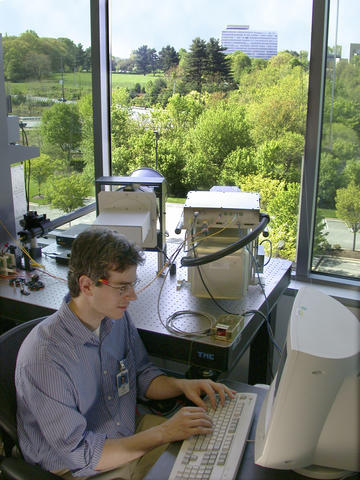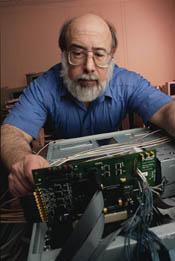
Physicist Joshua Bienfang sets up the NIST quantum key distribution system to receive a string of photons from colleagues stationed on the top floor of the NIST Administration Building (shown in the background.) The black instrument on the left is an 8-inch telescope used in collecting the incoming photons.
The fastest known cryptographic system based on transmission of single photons—the smallest pulses of light—has been demonstrated by a team at the Commerce Department's National Institute of Standards and Technology (NIST). The transmissions cannot be intercepted without detection, so that messages encrypted with the system can be kept secret.
The NIST "quantum key distribution" (QKD) system transmits a stream of individual photons to generate a verifiably secret key—a random series of digital bits, each representing 0 or 1, used to encrypt messages—at a rate of 1 million bits per second (bps). This rate is about 100 times faster than previously reported systems of this type.
The demonstration, described in the May 3 issue of Optics Express, is the first major reported result from a new NIST testbed built to demonstrate quantum communications technologies and cryptographic key distribution. The testbed provides a measurement and standards infrastructure for research, testing, calibrations and technology development. Scientists tested the QKD system by generating an encryption key that could be sent back and forth between two NIST buildings that are 730 meters apart. They are using the testbed to develop data-handling techniques associated with this type of encryption.

Acadia Optronics LLC of Rockville, Md., consulted on the system design and hardware. Partial funding for the project was provided by the Defense Advanced Research Projects Agency.
Quantum systems—exploiting the laws of quantum mechanics—are expected to provide the next big advance in data encryption. The beauty of quantum key distribution is its sensitivity to measurements made by an eavesdropper. This sensitivity makes it possible to ensure the secrecy of the key and, hence, the encrypted message. The keys are generated by transmitting single photons that are polarized, or oriented, in one of four possible ways. An eavesdropper reading the transmission causes detectable changes at the receiver. When such changes are observed, the associated key is not used for encryption.
Compared to previously described QKD systems, the major difference in the NIST system is the way it identifies a photon from the sender among a large number of photons from other sources, such as the sun. To make this distinction, scientists time-stamp the QKD photons, then look for them only when one is expected to arrive.
"To be effective, this observation time has to be very short," says NIST physicist Joshua Bienfang. "But the more often you can make these very brief observations, then the faster you can generate keys. We have adapted some techniques used in high-speed telecommunications to increase significantly the rate at which we can look for photons."
The NIST team has packaged data-handling electronics operating in the gigahertz (1 billion bits per second) range in a pair of programmable printed circuited boards that plug into standard PCs. Photon losses caused by imperfections in the photon sources and detectors, optics, and procedures reduce the key generation rate. However, 1 million bps makes QKD practical for a variety of new applications, such as large network distributions or streaming encrypted video.
"We are processing data much faster with this hardware than can currently be done with software," says NIST electrical engineer Alan Mink. "You would need a computer processing at more than 100 GHz (about 50 times faster than current PCs) to do it with software and you still couldn't do it fast enough because the operating system would slow you down."
The NIST quantum system uses an infrared laser to generate the photons and telescopes with 8-inch mirrors to send and receive the photons over the air. The data are processed in real time by printed circuit boards designed and built at NIST, so that a computer produces ready-made keys. NIST researchers also developed a high-speed approach to error correction.
Further research is planned to improve the system, primarily by addressing the need for faster photon detectors, the principal barrier to the development of practical systems for more widespread use. The group plans to incorporate NIST-developed photon sources and detectors. More information about NIST's quantum information program can be found online. [Link to inactive website removed on 11/14/2023]
As a non-regulatory agency of the U.S. Department of Commerce's Technology Administration, NIST develops and promotes measurement, standards and technology to enhance productivity, facilitate trade and improve the quality of life.
Learn more about quantum cryptography.

